
Original Link: https://www.anandtech.com/show/971
ABIT SR7-8X (SiS 648): DDR400-Powered
by Evan Lieb on August 20, 2002 3:07 AM EST- Posted in
- Motherboards
From the moment we started testing retail SiS 648 boards as well as SiS's own 648 reference board, it has been quite clear that the 648 chipset offers leading DDR performance for the Pentium 4 platform. Granted, the SiS 648's performance lead is pretty minor, but the 648 does bring some significantly improved features over from its predecessor the SiS 645DX (as we've covered several times before). So taking everything into consideration, it's pretty easy to see that the combination of cutting-edge DDR Pentium 4 performance, an impressive features-set, and dirt cheap prices leaves the SiS 648 as one of the most desirable Pentium 4 chipsets on the market.
Besides Intel, SiS's main competition in the Pentium 4 market is VIA and their P4X400 chipset, which still has yet to impress us with its DDR400 performance. Even though VIA and SiS both tell us that their latest chipsets don't officially support DDR400 (i.e. they're not fully validated for this unapproved memory type), so far SiS has been able to get the "fake" DDR400 that's available on the market to work with their "unofficial" DDR400 648 chipset. As was quite plainly illustrated in our recent 3-way P4 DDR400 article, our retail P4X400 and SiS 648 boards were simply unable to reliably run DDR400 memory. The 648 reference board SiS sent us was the only board able to reliably operate DDR400 memory at the time.
Fortunately, you won't need a SiS 648 reference board to make DDR400 work with a SiS 648-based board any longer. Meet the ABIT SR7-8X, the first retail SiS 648-based motherboard that actually works with "unofficial" DDR400 memory.
ABIT SR7-8X: Basic Features
|
Motherboard Specifications |
|
|
CPU
Interface
|
Socket-478
|
|
Chipset
|
SiS
648 North Bridge
SiS 963 South Bridge |
|
Bus
Speeds
|
100
- 200MHz (in 1MHz increments)
|
|
Core
Voltages Supported
|
up
to 1.70V in 5% increments
|
|
I/O
Voltages Supported
|
N/A
|
|
DRAM
Voltages Supported
|
up
to 2.8V in 0.1V increments
|
|
Memory
Slots
|
3
184-pin DDR DIMM Slots
|
|
Expansion
Slots
|
1
AGP 8X Slot
5 PCI Slots |
|
Onboard
RAID
|
N/A
|
|
Onboard
USB 2.0/IEEE-1394
|
USB2
Supported through South Bridge
|
|
Onboard
LAN
|
Realtek
8100B 10/100
|
|
Onboard
Audio
|
Realtek
ALC200 2-channel AC'97
|
We'll start off this section of the review with a look at some of the more basic features found on the ABIT SR7-8X motherboard.
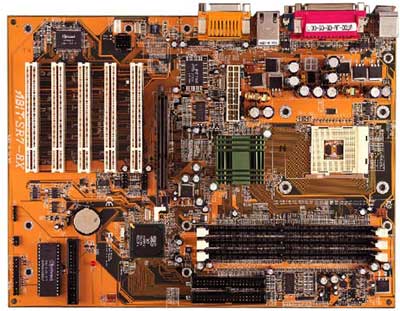
The SR7-8X is not a part of the now famous ABIT MAX series of motherboards that were introduced last March. As is quite apparent in the picture above, the ABIT SR7-8X is not legacy free like the ABIT MAX motherboards. The SR7-8X comes with conventional legacy ports options in the form of one PS/2 keyboard and PS/2 mouse connector, two serial port connectors, and one parallel port connector.
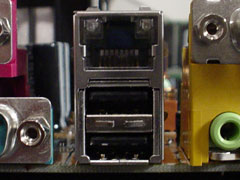
Continuing along we see two USB 2.0 ports situated below the standard 10/100 Ethernet port. These ports constitute the only non-legacy items of the I/O options.
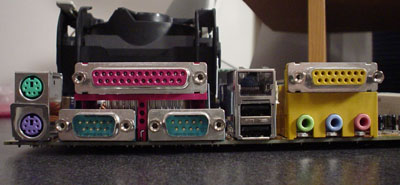
Rounding out the I/O options is the Game Port, with standard options for Line-in, Line-out, and Mic-in. Other additional features include two extra USB headers for an additional 4 USB channels, two CD audio input connectors, and three fan headers.
The SR7-8X has plenty of expansion slots to choose from with 5 PCI slots and 3 DIMM slots for up to 3.0GB of DDR200/266 memory or 2.0GB of DDR333 memory (2 DIMM slots). We should note that running 768MB of single-sided DDR333 Kingston memory at default settings (three 256MB sticks) was painless.
The SR7-8X also supports hard drives speeds of up to 133MB/s (ATA133), which is as good as it gets for IDE hard drive bandwidth. Since the SR7-8X doesn't come with any onboard RAID, you're stuck with just 2 IDE channels for a maximum of 4 IDE devices. This isn't a terribly low amount of choices actually, but there are certain users that require more than 4 IDE devices in a computer system.
Additionally, ABIT utilizes the SiS 648's integrated LAN functionality through the Realtek 8100B chip. The Realtek 8100B chip is located just above the left corner of the AGP 8X slot. ABIT also takes advantage of the SiS 648's native AC'97 sound functionality through the ALC200 chip (2-channel sound).
Of course, we can't forget the 648 chipset itself, constituted of the SiS 648 North Bridge and SiS 963 South Bridge. As we've covered here before, the SiS 648 includes features such as:
1. AGP 3.0 (or AGP 8X) support.
2. 1GB/s I/O interconnect, aka MuTIOL.
3. Official Northwood-B (533MHz FSB) support.
4. Native support for USB 2.0, 1394a (FireWire), ATA133, Ethernet, and basic 6-channel sound.
5. Unofficial support for DDR400 memory (SiS648 only "officially" supports as high as DDR333 memory).
Board Layout
The SR7-8X's layout is pretty clean in general. There aren't a lot of "extra" features such as RAID, FireWire, or Serial ATA. The plus side of this is that the SR7-8X's basic feature set results in a lower transistor count and therefore a lower selling price.
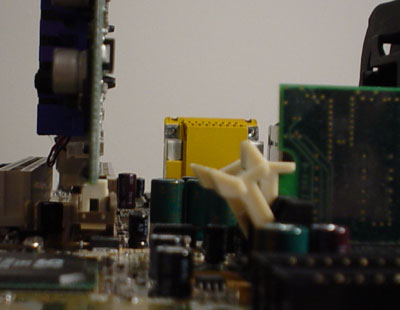
The cleaner layout makes for a somewhat trouble-free installation process. For example, there's enough room between the AGP slot and DIMM slots for installing and uninstalling RAM and video cards without the DIMM clips interfering. There are way too many boards on the market that have little-to-no room between the DIMM clips and an AGP card. Additionally, the capacitors around the CPU socket don't impede the uninstallation of the CPU heatsink, which is certainly convenient if you tend to upgrade CPU's or change heatsinks consistently.
 Some
of the minor complaints we had with the SR7-8X's layout was the positioning
of the 20-pin ATX connector, which is located right next to the I/O ports. While
this isn't too big of a deal, we still would have liked to have seen this connector
placed almost anywhere else, ideally above the 3 DIMM slots at the top right-hand
corner of the motherboard. Positioning the ATX connector this way makes it easier
to add/remove items inside an ATX case, which is certainly a convenient for
system builders.
Some
of the minor complaints we had with the SR7-8X's layout was the positioning
of the 20-pin ATX connector, which is located right next to the I/O ports. While
this isn't too big of a deal, we still would have liked to have seen this connector
placed almost anywhere else, ideally above the 3 DIMM slots at the top right-hand
corner of the motherboard. Positioning the ATX connector this way makes it easier
to add/remove items inside an ATX case, which is certainly a convenient for
system builders.
Additionally, ABIT adds a tiny green heatsink over the SiS 648 North Bridge for cooling. If you like having a quiet system, passive cooling over your North Bridge will certainly help.
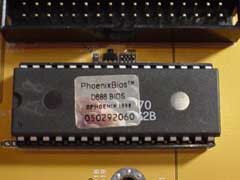
Shown above is the DIP package (Dual Inline Pin Package) BIOS chip ABIT chose for the SR7-8X (SoftMenu III); although the older DIP chips take up more room on motherboards, they're quite common on cheaper motherboards because of their low cost.
The ABIT SR7-8X motherboard uses the standard ATX form factor. Its dimensions are approximately 305 x 230 mm.
BIOS Setup and Overclocking Features
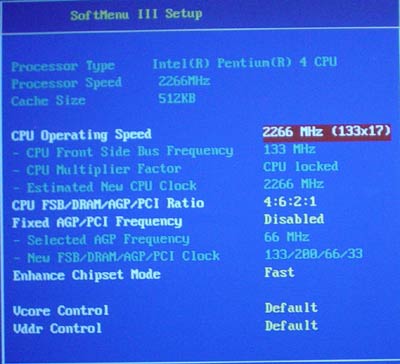
The SR7-8X utilizes the SoftMenu III BIOS setup utility; this BIOS setup is quite good, mostly due to the fact that there's lots of options and information available for your viewing pleasure. Whether you're talking about the PC Health or overclocking sections of SoftMenu III, there's always some type of useful information to constantly look at.
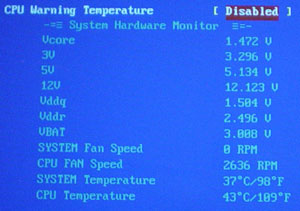
The SR7-8X, in general, is a fairly tweakable board. Northwood-A and Northwood-B users won't feel restricted by low FSB options with the SR7-8X, as the FSB is adjustable in 1MHz increments all the way up to 200MHz, which is plenty for most overclockers.
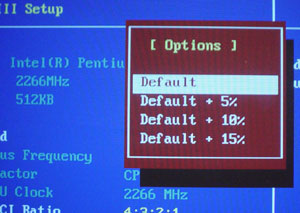
In theory, you're supposed to be able to adjust Vcore in the BIOS up to 15% of the default core voltage (1.5V = default Northwood-A/B Vcore), or as high as 1.725V. However, because the SR7-8X sets default core voltage slightly lower (~ 1.47V) than the Pentium 4's true 1.5V default Vcore, the highest attainable Vcore is actually only about 1.7V. In addition, the Vcore is adjustable in only 5% increments, meaning you have just three Vcore options between 1.47V and 1.7V, which isn't terrible but at the same time isn't great either.
Your VDIMM options aren't all that bad though. You can adjust memory voltages up to 2.8V in .1V increments, which should suit even the most serious overclockers. Usually however, it isn't necessary to increase memory voltage a lot unless you're overclocking your CPU and memory way out of spec.
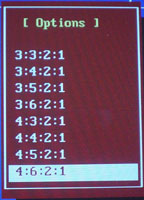 The
ABIT SR7-8X generally faired well in most of our overclocking tests, but wasn't as spectacular as we had hoped. We were able to push 144MHz FSB using a 2.26GHz Northwood-B
(533MHz FSB) processor. That comes out to a core clock speed of 2.45GHz, or almost a 200MHz
overclock. We used the retail HSF and thermal pad that comes with all retail
Pentium 4 processors and set Vcore to around 1.61V. Going beyond 144MHz FSB
proved unsuccessful even when the CPU was set to the maximum available Vcore
via the SoftMenu III BIOS. There were no other options for increasing Vcore
through onboard jumpers.
The
ABIT SR7-8X generally faired well in most of our overclocking tests, but wasn't as spectacular as we had hoped. We were able to push 144MHz FSB using a 2.26GHz Northwood-B
(533MHz FSB) processor. That comes out to a core clock speed of 2.45GHz, or almost a 200MHz
overclock. We used the retail HSF and thermal pad that comes with all retail
Pentium 4 processors and set Vcore to around 1.61V. Going beyond 144MHz FSB
proved unsuccessful even when the CPU was set to the maximum available Vcore
via the SoftMenu III BIOS. There were no other options for increasing Vcore
through onboard jumpers.
One very nice overclocking feature the ABIT SR7-8X brings to the table is an AGP/PCI lock. All you have to do is go into the BIOS and find the option for "fixing" the AGP/PCI ratio at 2:1. From there, your AGP/PCI buses will run at 66MHz/33MHz no matter how high the FSB is set. Interestingly enough, ABIT also gives you the ability to set your AGP/PCI buses to other higher settings than just 66MHz/33MHz. You could, for example, lock the AGP/PCI buses at 68MHz/34MHz and have the FSB set as high as you want. A pretty nifty feature if you ask us.
Stress Testing the ABIT SR7-8X
One of the most impressive aspects of the SR7-8X was its ability to complete our entire benchmark suite and stress tests with both DDR333 and DDR400 memory. While we've witnessed plenty of motherboards that could complete our benchmark suites with DDR333 memory, this is the first DDR Pentium 4 motherboard we've seen that could finish our benchmark suite and stress tests with DDR400 memory without encountering a single problem (of course, this excludes the SiS 648 reference board that obviously won't be in the channel).
As usual, we started off our stress tests with Prime95. We decided to see if the SR7-8X could handle 48 hours straight of Prime95 torture tests with DDR400 memory. Much to our delight, the board was able to finish all Prime95 torture tests after two days straight of testing with DDR400. Certainly not bad at all.
Of course, our stress tests wouldn't be complete without testing the SR7-8X with all three DIMM slots filled with memory. We were able to complete our entire benchmark suite with all banks filled with Kingston DDR333 memory at CL2.5 (SPD timings). Going down to CL2 with all other timings the same yielded similar results; our benchmark suite didn't experience any failures, and Prime95 was rock solid to the end.
The Test
|
Performance Test Configuration |
||
| Processor(s): |
Intel
Pentium 4 2.26B
|
|
| RAM: |
256MB Samsung DDR333 CAS2.5 module (M368L3223CTL-C (L) B3)
256MB Twinmos DDR400 CAS2.5 module |
|
| Hard Drive(s): |
Western Digital 120GB 7200 RPM
Special Edition (8MB Buffer)
|
|
| Bus Master Drivers: |
Latest SiS drivers and patches
|
|
| Video Card(s): |
NVIDIA
GeForce3 Ti 200
|
|
| Video Drivers: |
NVIDIA
Detonator 29.42
|
|
| Operation System(s): |
Windows
XP Professional
|
|
The AnandTech Motherboard Testbed was Sponsored by Newegg. You can buy the components we used to test at www.newegg.com.
Content Creation & General Usage Performance
SYSMark has become a solid measurement of overall system performance since its induction into our benchmarking suite. Although the Internet Content Creation suite caters to more of a niche market, the Office Productivity tests are a perfect measurement of overall system performance in the applications all of us use on a daily basis.
The applications benchmarked include:
· Internet Content Generation: Adobe Photoshop® 6.01, Adobe Premiere® 6.0, Microsoft Windows Media Encoder 7.1, Macromedia Dreamweaver 4, and Macromedia Flash 5
· Office Productivity: Microsoft Word 2002, Microsoft Excel 2002, Microsoft PowerPoint 2002, Microsoft Outlook 2002, Microsoft Access 2002, Netscape Communicator® 6.0, Dragon NaturallySpeaking Preferred v.5, WinZip 8.0, and McAfee VirusScan 5.13.
For more information on the methodology and exactly what SYSMark does to generate these performance scores check out BAPCo's SYSMark 2002 Whitepaper.
|
|
As you can see here, the ABIT board is performing very close to SiS' own 648 reference board.
Quake III Arena Performance
Quake III's usefulness as a gaming benchmark has diminished mostly because of the fact that we're able to consistently produce frame rates over 300 fps at 1024x768 with the fastest video cards. But as the benchmark becomes less GPU limited, it becomes a perfect candidate for CPU and platform tests such as this one.
|
Once again, the ABIT board finds itself on the heels of the SiS 648 reference platform.
Unreal Tournament 2003 Performance - High Detail
We introduced the latest Unreal Tournament 2003 benchmark in our GPU Shootout article a few weeks back and we're continuing to use it as an example of a next-generation game test.
We benchmarked under two different levels and detail settings; the first was DM-Antalus with High Detail settings, an overly GPU bound benchmark, and the second was DM-Asbestos with Medium Detail settings.
|
|
Unreal Tournament 2003 Performance - Medium Detail
|
|
High End Workstation Performance - SPEC Viewperf 7.0
The latest version of SPEC Viewperf proves to be an excellent stress test for memory bandwidth and overall platform performance as you're about to see. The benchmarks included version 7 of the benchmark suite are:
3ds max (3dsmax-01)
Unigraphics (ugs-01)
Pro/Engineer (proe-01)
DesignReview (drv-08)
Data Explorer (dx-07)
Lightscape (light-05)
For more information on the tests run visit SPEC's page on the new Viewperf benchmark.
|
|
|
|
|
|
Final Words
Having tested several SiS 648 motherboards so far, the ABIT SR7-8X has certainly impressed us in terms of being able to run "unofficial" DDR400 memory. The ability to run DDR400 at this point gives us a good idea of how well ABIT designed the SR7-8X for running outside the usual specifications of the platform. We'll obviously need to test many more 648 boards to get a feeling for what this chipset is made of, but we now have a better idea of what to expect.
We'd also like to emphasize the price tag of the ABIT SR7-8X. Currently, the price range for ABIT SR7-8X motherboards hover around $100. Considering features like onboard sound and LAN in addition to the top-notch DDR400 performance and compatibility the ABIT SR7-8X brings to the table, we're confident that most will find the price quite acceptable. Excluding the ABIT SR7-8X's somewhat dismal overclocking results, we can confidently conclude that the ABIT SR7-8X is the most impressive "unofficial" DDR400 Pentium 4 motherboard on the market in terms of price, performance and stability.
In the near future we'll be bringing you lots more coverage of SiS 648-based motherboards in addition to several other "unofficial" DDR400 motherboards based on both the Pentium 4 and Athlon XP platforms.







